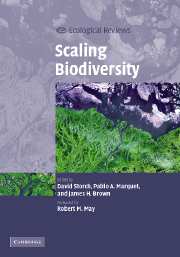Book contents
- Frontmatter
- Contents
- List of contributors
- Foreword by Robert M. May (Lord May of Oxford)
- Preface
- 1 Introduction: scaling biodiversity – what is the problem?
- PART I Spatial scaling of species richness and distribution
- PART II Alternative measures of biodiversity: taxonomy, phylogeny, and turnover
- PART III Scaling of biological diversity with energy and the latitudinal biodiversity gradient
- PART IV Processes, perspectives, and syntheses
- 16 Spatiotemporal scaling of species richness: patterns, processes, and implications
- 17 Scaling biodiversity under neutrality
- 18 General patterns in plant invasions: a family of quasi-neutral models
- 19 Extinction and population scaling
- 20 Survival of species in patchy landscapes: percolation in space and time
- 21 Biodiversity power laws
- Index
- Plate section
- References
21 - Biodiversity power laws
Published online by Cambridge University Press: 05 August 2012
- Frontmatter
- Contents
- List of contributors
- Foreword by Robert M. May (Lord May of Oxford)
- Preface
- 1 Introduction: scaling biodiversity – what is the problem?
- PART I Spatial scaling of species richness and distribution
- PART II Alternative measures of biodiversity: taxonomy, phylogeny, and turnover
- PART III Scaling of biological diversity with energy and the latitudinal biodiversity gradient
- PART IV Processes, perspectives, and syntheses
- 16 Spatiotemporal scaling of species richness: patterns, processes, and implications
- 17 Scaling biodiversity under neutrality
- 18 General patterns in plant invasions: a family of quasi-neutral models
- 19 Extinction and population scaling
- 20 Survival of species in patchy landscapes: percolation in space and time
- 21 Biodiversity power laws
- Index
- Plate section
- References
Summary
Introduction
The last ten years have been marked by important discoveries and scientific advances in our understanding of biodiversity. The emergence of new fields, such as bioinformatics, ecoinformatics, and computational ecology (Helly et al., 1995; Spengler, 2000; Green et al., 2005) has brought about an informational revolution by making available massive data sets on the composition, distribution and abundance of biodiversity from local to global scales and from genes to ecosystems. This has in turn changed biodiversity sciences, expanding the scale of analysis of ecological systems wherein biodiversity resides. While the 1970s and 1980s were marked by studies at local scales, the 1990s were marked by gaining access to regional, continental and global scale analyses. In parallel, and in part as a consequence of the above trend, there has been a shift from approaches that emphasize the highly variable and idiosyncratic nature of ecological systems to a view that emphasizes the action of first principles, natural laws and zeroth order approaches (the macroscopic approach hereafter).
The small-scale approach can be illustrated by a representative quotation from Diamond and Case (1986, p. x): “The answers to general ecological questions are rarely universal laws, like those of physics. Instead, the answers are conditional statements such as: for a community of species with properties A1 and A2 in habitat B and latitude C, limiting factors X2 and X5 are likely to predominate.”
- Type
- Chapter
- Information
- Scaling Biodiversity , pp. 441 - 461Publisher: Cambridge University PressPrint publication year: 2007
References
- 6
- Cited by



